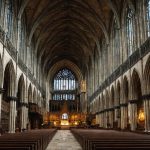Top Architectural Gems in the UK
The United Kingdom boasts an abundant collection of architectural landmarks that reflect its rich history and diverse design movements. Each of these sites tells a captivating story, making them must-visit sites for architecture enthusiasts and curious travellers alike.
Among the most iconic historic buildings is Westminster Abbey in London, a stunning example of Gothic architecture. Known for its breathtaking vertical lines and intricate details, the Abbey serves not only as a place of worship but also as a monument to British history, hosting numerous coronations and royal weddings.
Also read : Uncover the Premier UK Guided Tour Spots for Immersive British Aviation History Experiences
Venturing to Edinburgh, the Holyrood Palace stands as a classic representation of Baroque architecture. This historic building holds the fascinating tales of past monarchs, showcasing grand halls and ornate decorations indicative of its era.
In addition to these, the modern architectural scene should not be overlooked. The Eden Project in Cornwall, with its enormous biomes, presents a marvel of contemporary design, blending nature and innovation.
This might interest you : Exploring the Magic of Medieval UK Cathedrals: The Ultimate Historian’s Guided Tour Directory
Each landmark is uniquely characterized by its historical significance and the era’s design ethos it represents. When visiting, one not only admires the beauty but also delves into the historical narrative, uncovering the layers of the UK’s architectural evolution.
Noteworthy Guided Tours Available
Embarking on a guided architecture tour is an exhilarating way to explore the UK’s architectural landmarks. These tours provide exclusive insights into historic buildings, offering an enriched travel experience. Among the most popular are expert-led walking tours, granting close-up admiration of design nuances. They often cover iconic sites, revealing the stories and historical significance behind their facades.
Alternatively, bus tours present a convenient option, especially for those eager to cover large areas. These often incorporate audio guides delivering engaging narratives about must-visit sites. Both types prove rewarding, yet they cater to different visitor preferences.
Expert-led experiences significantly elevate these tours. The qualifications of tour guides, often historians or architects, ensure a profound understanding of design movements. Their expertise aids travelers in grasping unique features that define the UK’s architectural identity.
Tour itineraries can offer glimpses into architectural diversity, spanning Gothic to Modernist feats. These tours illustrate how architecture serves as a canvas for shifting historical narratives and stylistic transitions. Each guided excursion amplifies appreciation for the UK’s rich architectural tapestry, transforming visitor perceptions of these institutional spaces.
Planning a guided tour invites the opportunity to step into living history and embrace the richness of architectural styles interwoven across centuries.
Exploring Architectural Styles
Exploring architectural styles in the UK offers a unique glimpse into the country’s evolving design movements. Each style reflects distinct historical contexts and influences that have shaped the nation’s architectural identity over time.
Gothic Architecture
Gothic architecture in the UK is characterised by its soaring vertical lines and elaborate details. These structures, like Westminster Abbey, boast ribbed vaults and pointed arches, which add to their grandeur. Originating in the 12th century, Gothic structures were integral to expressing the devotional intensity of the medieval era, providing spaces that facilitated spiritual transcendence.
Neoclassical Influence
The neoclassical style, popularised during the 18th century, drew inspiration from ancient Greek and Roman architecture. It is recognised by its symmetrical shapes and grandiose columns, often seen in civic buildings such as the British Museum. This style emerged as a reaction to the perceived excesses of Baroque design, promoting ideals of clarity and order through its structured aesthetic.
Modernist Trends
Modernist architecture in the UK, developing in the early 20th century, emphasises function over form, often featuring minimalist designs and innovative materials. The Eden Project is a prime example, reflecting the era’s emphasis on innovation and pragmatism. Modernist structures highlight how architecture has evolved to meet contemporary needs while embracing new technologies and ideas.
Engaging Storytelling Around Architectural Gems
Architectural stories breathe life into the UK’s abundant architectural landmarks, weaving together cultural significance and captivating narratives. These stories, often passed down through generations, enrich visitors’ understanding by intertwining with the structural brilliance of these must-visit sites.
Throughout the UK, tales abound around these historic buildings. For instance, Westminster Abbey not only stands as a Gothic masterpiece, but it also embodies a rich tapestry of royal and national ceremonies. Each stone tells a story of coronations, weddings, and funerals that have shaped the nation’s history.
Similarly, Holyrood Palace echoes with the footsteps of past monarchs, each room a silent witness to pivotal moments of the Baroque era. These stories lay the groundwork for a more profound appreciation of the buildings’ roles in architectural styles and design movements.
These narratives are more than historical recounts; they are an invitation to step into the past, blending historical context with architectural features. The Eden Project showcases contemporary design, blending environmental narratives and technological innovation to forge a striking vision of the future.
Engaging tales such as these allow architecture to serve as a reflection of societal evolution, offering a dynamic lens through which to explore the UK’s architectural heritage. The stories embedded in these structures make each visit an enlightening journey through time.
Tips for Planning Your Architectural Tour
Planning an architectural tour in the UK can be a rewarding experience with careful consideration of timing and logistics. Understanding travel tips and gathering relevant visitor information can enhance your visit.
When planning your tour, consider visiting during the late spring or early autumn. These seasons often provide mild weather, making it more enjoyable to explore architectural landmarks and historic buildings without the crowds. Furthermore, booking tours in advance ensures availability, particularly for must-visit sites.
Practical considerations play a crucial role in ensuring a comfortable experience. Wearing comfortable footwear is essential as many tours involve extensive walking. Additionally, checking accessibility options ahead of time ensures that those with mobility challenges can fully participate in the tours.
Enhancing your tour experience is achievable through photography and note-taking. Capturing images of structures allows you to revisit and appreciate the subtleties of design movements later. Taking notes can help retain context and stories shared by tour guides, enriching your understanding of the historical significance tied to each site.
By considering these travel tips and insights, visitors can optimise their architectural journey, uncovering the beauty and stories of UK’s insightful architecture in an engaging way.
User Reviews and Personal Experiences
Engaging with user reviews and personal experiences can greatly enhance your appreciation of the UK’s architectural tours. Many visitors find that testimonial insights offer invaluable perspectives on their journeys through architectural landmarks. Reviews often highlight unexpected moments of connection with the historic buildings they visit, underscoring the emotional resonance these sites can provoke.
Visitors frequently note the vibrancy of guided tour experiences, appreciating the blend of historical context with personal anecdotes shared by guides. One common theme is the admiration for expert-led insights, which transform the tour into a rich tapestry of stories and visual splendor. Participants often recommend specific tours based on the uniqueness of the narrative and architectural knowledge imparted.
Travel experiences shared in reviews often touch upon logistical aspects, such as the ease of booking and the hospitality of guides. Personal stories within these reviews frequently point to the profound impact of visiting must-visit sites, where history feels palpable, and architectural grandeur leaves a lasting impression.
For future visitors, these user-generated insights serve as a guiding light, offering practical advice and heartfelt recommendations on which tours to select and what to expect, thus making the journey both engaging and fulfilling.










